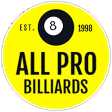In previous episodes, you learned about the physical aspects of taking a pool shot: you learned about stance, bridge hand placement, gripping the cue, and the types of bridges to use. In this episode, Anthony discusses your mental game. Specifically, he covers what should be running through your mind when you look at a shot.
Transcription
Hello, I’m master instructor Anthony Beeler and today I want to talk to you about mental game and some of the decisions that you’ll be making when you’re playing a game of pool. To help you make those decisions, it’s often helpful to remember the acronym P.A.S.S.. Never pass up a good shot. The first element is look for potential problems. The second element is whenever you come to a shot, look at the angle of that shot. Then determine what speed you’re going to strike the shot with and what spin you’re gonna use. Once you make all those decisions, then all you have to do is go to the table and execute the shot. Let’s go to the table and see what the decision-making process looks like.
As you can see, we’ve got a layout of balls here that we’ve got to decide how we’re going to run. The first thing we want to do is to stand away from the table so we can see the relationship that each ball has to the other. If you stand up too close, then you might not be able to see all the balls with one visual sweep. If you stand further away, it’s much easier to see how one ball relates to the other in the grand scheme, especially when you’re trying to run a layout of balls.
So, once you’re standing out here you’re going to develop a plan. And my plan would be to pocket the 2 in this pocket, shoot the 5 in this side, and then float down for the 9 to go in that pocket. Once you develop a plan, then you’re gonna go through your acronym. The first part of the acronym that I’m going to look at is the angle of the shot [editor’s note: although the acronym starts with "P", for potential problems, it typically comes last in actual play… it got moved to the front because A.S.S.P. doesn’t make a very good acronym]. I’ve got a slight angle to the left on the 2, I need to shoot it with a slow to medium speed and with low-right spin to get it on the 5 ball.
As far as potential problems go, the only problem that I can foresee in this scenario would be if I get on the wrong side of the 5. If I stay up here somewhere, it’s very easy for me to pocket the 5 and float down for the 9. But if I end up on this side of the 5, then that’s a problem. So, whatever I do here, I want to be sure that I don’t overhit this shot. I’d rather end up a little bit short than go too far.
So, once all of my decisions have been made, I’m just going to rest my brain and execute the shot. So, here we’re gonna get our distance, take a couple of practice strokes… 1, 2, 3 [pulls back] 1, 2 [hits shot] 1, 2, 3, 4.
Now I’m gonna get back up, and go through the process again. This time, I’ve got a slight cut to my right, which is what I wanted. So, the speed that I’m gonna strike the shot with is gonna be a slow to medium speed, the spin is gonna be low-left, and as far as avoiding potential problems here: I don’t want to end up frozen on the rail somewhere. I just want to be out here in the middle of the table, somewhere in this vicinity so that I’ve got a pretty easy shot on the 9.
Again, once those decisions have been made I’m gonna rest my brain and I’m just gonna move into execution mode. [gets down on shot] 1, 2, 3 [pulls back] 1, 2 [hits shot] 1, 2, 3, 4.
On this last shot I’ve got a slight angle to the left, the speed I’m gonna strike it with is just a slow speed, and I don’t need any spin because I’m not playing position on anything. So I’m just gonna move down into execution mode, and the main thing that I wanna do here is to just be sure that I’m gonna pocket the ball. [gets down on shot] 1, 2, 3 [pulls back] 1, 2 [hits shot] 1, 2, 3, 4. And that’s the decision making process.
When making decisions at the table, it’s important to remember the acronym pass. Look for potential problems. Determine what angle that you have on your shot, what speed you need to strike it with, and what spin you need to use. If you implement all of these elements, I think it will help you to move your cue ball from one shot to the next more effectively.
The post Anthony Beeler Instructional Lesson #6: Mental Game appeared first on McDermott Cue Blog.



0 Comments